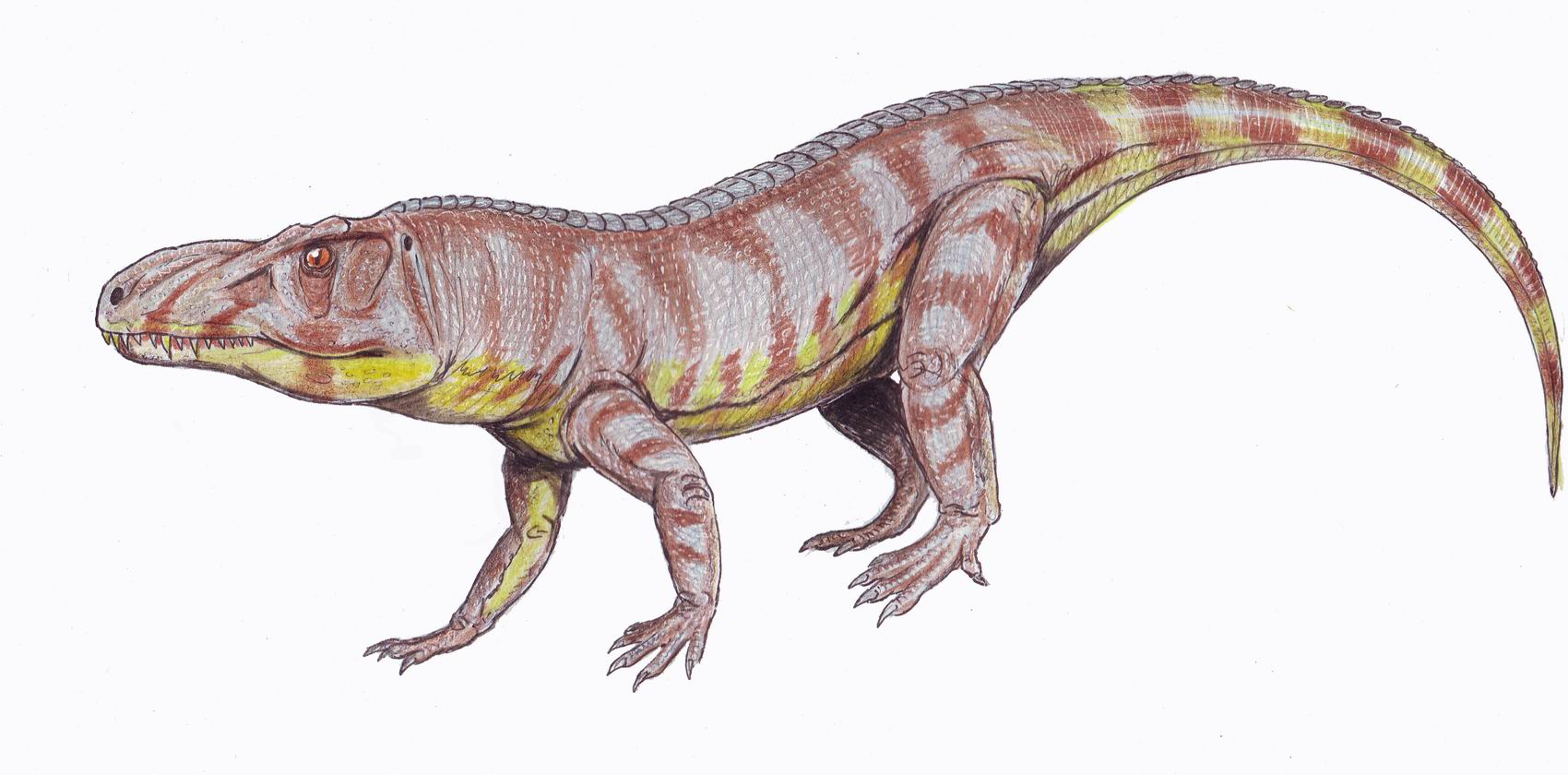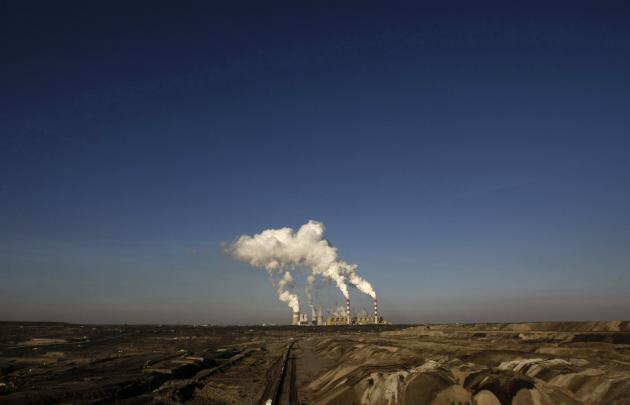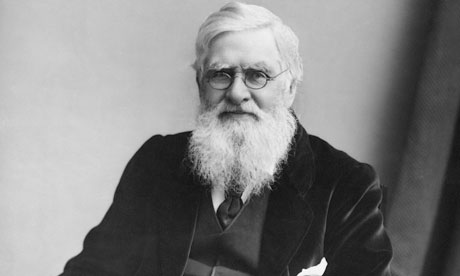Coprolites (fossilised faeces) are trace fossils that give an insight into the diet and digestive processes of long-extinct animals that we cannot get from their body fossils as the soft parts of an animal generally aren't preserved as fossils.
Palaeontologists working in Argentina have found a communal toilet area used by Dinodontosaurus with a remarkable density of 94pm-2 (poos per square metre!). The geological implications of this are fascinating in terms of what it can tell us about the behaviour of an early predecessor of the dinosaurs. The benefits of having a defined place for a toilet are obvious as parasites may be less of a problem and food and faeces aren't mixed. It could also have been a way for the Dinodontosaurus to ward off the crocodile-like predator Luperosuchus.
What I find interesting about this is that it implies some type of social organisation for these animals, something we don't see in modern cold-blooded animals. What do you think caused these animals to behave in this way?
There's no denying it, we all want and expect energy in abundance. However as Ted Nield (editor of Geoscientist) put it "Everybody wants energy, as much of it as possible, and cheap. And nobody wants it to be generated - or its feedstocks extracted - by any method whatever, anywhere at all, and certainly not near where they live - unless they become rich in the process, in which case it’s fine, because they can move somewhere else."
Two stories have highlighted the dilemma that energy poses. Planning permission for an open cast coal mine in the Valleys has been refused because of competing local interests. Do we want the jobs and the energy security that this will bring or are we happy to import the coal that we all use and need from "somewhere else"? The BBC's Environment Editor has summed it up quite succinctly - "Why is everyone so angry about generating electricity?"
As a society we need to accept the geological, georgaphical and scientific realities of energy generation because we simply cannot have it all.
How do you think we should resolve these issues?
We need the Earth to have a magnetic field to keep our atmosphere where we need it to be. Over the last few decades it has become apparent that the field is weakening; this may just be part of a natural variability in the strength of the field but it does highlight the fact that we don't know enough about it.
In order to try to understand the field it is essential that we make a map of it. The European Space Agency has launched three satellites today to map the field. They will hopefully provide some answers about a crucial aspect of the Earth's physics and possibly help to find mineral resources as well.
This mission is part of the ESA's Earth Explorer Programme.
Every so often a volcano erupts out of the ocean to form a new island. The most famous of these is an island called Surtsey, close to Heimaey off the south coast of Iceland. Since it emerged in 1963 it has been intensively studied by geologists and biologists to investigate rates of erosion and colonisation of new landmasses.
This formation of a new island has happened again, this time off the coast of Japan. Video of the eruption (taken from planes flying over the volcano) clearly show the volcanic processes that have built the volcano to such an extent it has grown above sea level.
For those of you writing your letters to Santa I have a suggestion. The world's most complete Diplodocus fossil is for sale. It was found in America by a German, assembled in the Netherlands and is now on display (and for sale in the UK). It does have an auction estimate of between £400,000 and £600,000 and you will be competing against museums and collectors in Europe and Asia. You will need a big house to put it on display as this specimen is 17 metres long, but it would be a talking point for anyone who comes to visit.
It is a complicated relationship that, to an extent, we share. Poland relies on coal to generate its own electricity, as a major employer and as a source of export income (which is where we have some interest - the UK imported 549,900 tonnes of Polish coal in the first half of 2013). However this isn't without cost - coal is an undeniably "dirty" fuel in terms of carbon dioxide, sulphur gases and particulates. To the point where people in coal mining areas in Poland don't want the industry that they rely on - as I said it is a complicated relationship.
It isn't just the Poles who need to make decisions about our future sources of energy, we too are facing some serious choices in the short term to balance our energy security and independence with the need to protect the environment. Whatever decisions are made, geologists will have to be involved in the science that must be the basis for any choice we make.
What do you think we should do?
A rare pink diamond has sold for £52,000,000 which, it has to be said, is quite a lot of money for soething that started out its existence as organic material on the sea bed. A trip down a subduction zone and back again via a volcano turned some carbon into an object that is worth the price of 2 new schools or would pay over 1,600 teachers for a year.
Looking at the specimen close up shows that it is flawless and vivid pink in colour. Perhaps that explain why someone would pay £4,362,416.11 per gramme, over 170,000 times more than gold.
A Griffith Crack is a mechanism to explain how rocks, which can be very strong materials, are fractured by stress in the crust. Microscopic cracks in the rock, which can be the result of a flaw or inclusion in a mineral, will concentrate the tensile stress in a rock. This can lead to the expansion (or propagation) of the crack and even to failure of the rock resulting in a fault.
Europe's most active volcano is at it again. Eruptions over the weekend had lava fountains lighting up the night sky over Sicily.
Despite the frequency of volcanic activity, Etna poses little risk to surrounding setlements because of the mafic composition of its magma. It does put on a good show though.
A dogger is a concretion, a mass of sedimentary rock that has been cemented more than the surrounding rock. These often weather out of their original rock, the most spectacular examples in the UK are those in Laig Bay on the Isle of Eigg (shown above). The Moeraki Boulders on the South Island of New Zealand are another example of this feature.
The name was also used as a term, though now superseded, for the Middle Jurassic.
It is 100 years since possibly Wales' greatest scientist died. Alfred Russel Wallace was born in Usk, Monmouthshire but found fame in his lifetime for the work he did in what is now Indonesia. He was the co-discoverer of the theory of evolution by natural selection, though because the other scientist to discover the idea (Charles Darwin) wrote the book - he got most of the credit.
Although most of Wallace's work was biological he did make some discoveries, other tha evolution, that have some geological significance. He defined the study of biogeography and worked out one of the earliest pieces of evidence that would,after his death, be explained by plate tectonics - the Wallace Line.
Although he was one of the most famous scientists of his day, he fell into obscurity after his death. This is being rectified with a new statue that has been installed at the Natural History Museum. His is an inspiring story of scientific excellence, utter determination and modesty despite his obvious talents - he is a Welshman to admire.
Boudinage is from a French word meaning "sausages". It is a distinctive structure formed by extension of a competent rock under tensional stress where it is surrounded by incompetent rock. The competent rock starts to break up forming the sausage-like structures shown in the photograph. This can even happen on a microscopic scale within a rock where the process is called Rodding.
Argentinosaurus is a member of a group of dinosaurs that are the biggest animals ever to have lived on land - the Sauropods. This giant size presents a lot of questions for palaeontologists to answer about how they lived: how did they eat enough to survive? how did they breed? how quickly did they grow? and how did they move around?
This last question is particularly tricky, especially when we consider that Argentinosaurus was at least 10 times heavier than an elephant. New research has used computer models to investigate how these giant animals could move as the problem comes down to the maths behind the movement. Let me explain:
As the length of an animal increases, the weight of the animal increases by a cube (power of 3) because the weight is a property of the animals volume. However the force that the muscles can generate only goes up by a square (power of 2) because they are limited by the area of muscle connection to the bone.
The conclusion is that these animals are at the limit of the size that flesh and bone can support on land but they must have had lots of adaptations to cope with the stresses on their bodies - such as limited joint movement to keep them steady. Clearly, size isn't everything.












